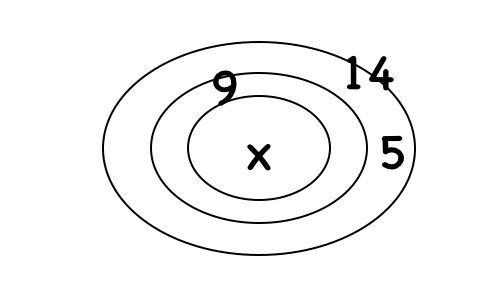Online Course Discussion Forum
Math Challenge II-A Combinatorics Series
Hello,
For problem 4.8 in the example questions, I thought of a different solution that should work. I tried figuring out where it went wrong but did not find any errors. Here is my solution:
In total, there are 33 As, made by 14 students, because those 14 students are the ones that "contributed" at least 1 A. 9 of the students "contributed" at least 2 As. So therefore they "contributed" at least an extra 9 As. However, 14+9=23 As. So that means there are 10 students that "contributed" 3 As. (1 in the first "round", 1 in the second "round" and 1 in the last "round")
Note that in my solution, the number of students that got 3 As should be less than 9, because that is the number of students that got 2+ As. Then I tried another solution:
 the first circle is the number of students who got As, the second circle is the number of students who got 2 As, the third is the number of students that got 3 As. Setting up an equation: 5+2(9-x)+3x=11*3 but solving, I got x=10 again.
the first circle is the number of students who got As, the second circle is the number of students who got 2 As, the third is the number of students that got 3 As. Setting up an equation: 5+2(9-x)+3x=11*3 but solving, I got x=10 again.
Can you see where it is wrong on both solutions?
Thanks!
I think there's one part of the wording of the original question that's a little confusing here. The phrase that is important is "exactly 9 students get A's on any two exams". That means if you pick any two exams, for example the 1st and 2nd exam, there are exactly 9 students who got an A on both. (Note further what the students get on the 3rd exam does not matter for this statement.)
Thus, try to fill in a Venn diagram with how many students got A's on each specific test:
For example, we know that in total "Test 1" should have 11 students somewhere in it's four sections, and the same for "Test 2" and "Test 3".
It looks like you were doing a slightly different question, where you were assuming:
- exactly 11 students get A's on each exam
- 9 students get A's on at least two exams (this is the one that isn't quite right)
- 14 students get an A on at least one exam
Under these assumptions your work is good. HOWEVER, the question doesn't make sense in that scenario, because if 10 students get A's on at least 3 exams, that would mean that 10 (not 9) got A's on at least two exams, so things don't work.
Hope this helps!
Social networks